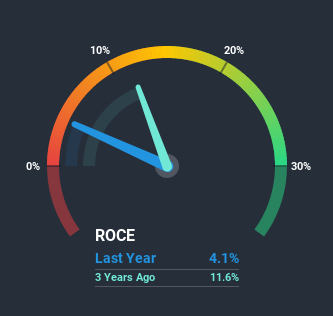Should We Be Excited About The Trends Of Returns At Capral (ASX:CAA)?

Want to participate in a short research study? Help shape the future of investing tools and earn a $40 gift card!
To find a multi-bagger stock, what are the underlying trends we should look for in a business? One common approach is to try and find a company with returns on capital employed (ROCE) that are increasing, in conjunction with a growing amount of capital employed. Basically this means that a company has profitable initiatives that it can continue to reinvest in, which is a trait of a compounding machine. Having said that, from a first glance at Capral (ASX:CAA) we aren't jumping out of our chairs at how returns are trending, but let's have a deeper look.
What is Return On Capital Employed (ROCE)?
For those that aren't sure what ROCE is, it measures the amount of pre-tax profits a company can generate from the capital employed in its business. To calculate this metric for Capral, this is the formula:
Return on Capital Employed = Earnings Before Interest and Tax (EBIT) ÷ (Total Assets - Current Liabilities)
0.041 = AU$7.6m ÷ (AU$282m - AU$94m) (Based on the trailing twelve months to December 2019).
So, Capral has an ROCE of 4.1%. In absolute terms, that's a low return and it also under-performs the Metals and Mining industry average of 9.8%.
See our latest analysis for Capral
Historical performance is a great place to start when researching a stock so above you can see the gauge for Capral's ROCE against it's prior returns. If you're interested in investigating Capral's past further, check out this free graph of past earnings, revenue and cash flow.
What Can We Tell From Capral's ROCE Trend?
There are better returns on capital out there than what we're seeing at Capral. The company has employed 59% more capital in the last five years, and the returns on that capital have remained stable at 4.1%. Given the company has increased the amount of capital employed, it appears the investments that have been made simply don't provide a high return on capital.
In Conclusion...
In summary, Capral has simply been reinvesting capital and generating the same low rate of return as before. And investors may be recognizing these trends since the stock has only returned a total of 2.6% to shareholders over the last five years. Therefore, if you're looking for a multi-bagger, we'd propose looking at other options.
One more thing: We've identified 4 warning signs with Capral (at least 1 which is significant) , and understanding these would certainly be useful.
For those who like to invest in solid companies, check out this free list of companies with solid balance sheets and high returns on equity.
This article by Simply Wall St is general in nature. It does not constitute a recommendation to buy or sell any stock, and does not take account of your objectives, or your financial situation. We aim to bring you long-term focused analysis driven by fundamental data. Note that our analysis may not factor in the latest price-sensitive company announcements or qualitative material. Simply Wall St has no position in any stocks mentioned.
Have feedback on this article? Concerned about the content? Get in touch with us directly. Alternatively, email editorial-team@simplywallst.com.

 Yahoo News
Yahoo News 

